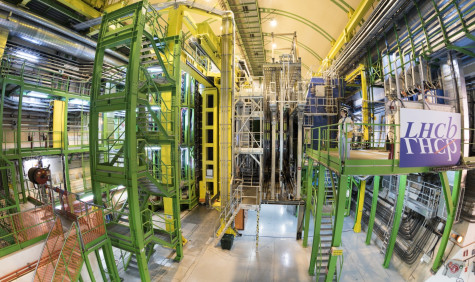LHCb experiment cavern | © 2016 CERN
SURF and members join efforts in the novel field of quantum computing: from quark to quantum
Billions of collisions 100 meters underground
Every second there are millions of particles colliding at the LHCb experiment in CERN. The data generated by these collisions is so large that it must be filtered in real-time. This is a huge computational challenge. Both due to the large volumes of data and due to the complexity of the algorithms behind the selection of interesting events.
The problem
The main data challenge in the LHCb experiment at CERN is that of real-time particle track reconstruction. Due to the high rates of particle collisions at the LHC (of around 40 MHz), data rates can exceed 2 TB/s. Currently, data is reconstructed in real-time and selection of interesting events is done on the fly, reducing the data rate to about 12.5 Khz (0.6 GB/s). However, operations at the High-Luminosity LHC will increase the simultaneous particle collisions in the future, drastically challenging the online event reconstruction.\
The goal: explore quantum computing approaches to the problem
In this project, Maastricht University, Nikhef, CERN and SURF will address some specific challenges for the LHCb experiment in order to determine which elements of the data analysis chains (including the generation of simulated events and their analysis) are best suited for a quantum computing approach. This project aims to 1) explore and develop state-of-the-art quantum computing approaches in high energy physics, 2) establish a knowledge base at SURF and in the Netherlands and 3) act as a proof-of-concept environment to experiment with novel algorithms at a scale that is realistic to identify computational and algorithmic bottlenecks.
Some background: what happened after the Big Bang?
LHCb is an experiment set up to explore what happened after the Big Bang that allowed matter to survive and build the Universe we inhabit today. Fourteen billion years ago, the Universe began with a bang. Crammed within an infinitely small space, energy coalesced to form equal quantities of matter and antimatter. But as the Universe cooled and expanded, its composition changed. Just one second after the Big Bang, antimatter had all but disappeared, leaving matter to form everything that we see around us — from the stars and galaxies, to the Earth and all life that it supports.
